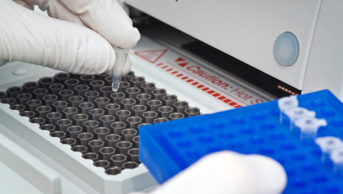Anil Kapoor came from a family of doctors. Having become a leading urologist and renal transplant surgeon at St Joseph’s, Hamilton, Canada, it came as a shock when — aged only 58 years — he received a diagnosis of colorectal cancer. He was prescribed a chemotherapy regimen called ‘FOLFOX’, which includes 5-fluorouracil (5-FU), a medicine used to treat several different cancers. “None of us knew anything about these drugs,” says Vimal Kapoor, an emergency doctor at Markham Stouffville Hospital in Markham, Canada, and Anil’s younger brother.
Before receiving the drug, Anil was screened for five common variants in the DPYD gene, which can lead to reduced activity of the dihydropyrimidine dehydrogenase (DPD) enzyme. The DPD enzyme is necessary for 5-FU breakdown and, if it is less active than it should be, the build-up of 5-FU can be toxic. Anil did not have any of the variants and so he was given the green light to go ahead.
“We didn’t know anything about genetic screening, we didn’t even know that he had it done,” Vimal says. He does recall Anil getting his first dose of 5-FU. “He felt perfectly fine getting that bolus.” Anil went back to work the following day.
A few days later, he started to feel “abruptly unwell in his clinic”, Vimal says. A few weeks later he was admitted to an intensive care unit. Shortly after that, on 28 February 2023, Anil died.
“The day he died, we did not know what killed him,” Vimal says. It was only after the oncologist sent his brother’s blood to be tested again that the family found out that Anil had a different variant allele in his DPYD gene — not one of the five he had been tested for — that results in reduced activity of DPD. In other words, the initial genetic testing had failed to pick up the variant that ultimately led to Anil’s death.
Different ancestries have not been represented in the studies and, therefore, we don’t know what other variants are more prevalent in those populations
Dharmisha Chauhan, lead pharmacist for the North Thames Genomic Medicines Service Alliance
“The DPYD variants that we [test for] are based on people of European ancestry,” says Dharmisha Chauhan, lead pharmacist for the North Thames Genomic Medicines Service Alliance. “Different ancestries have not been represented in the studies and, therefore, we don’t know what other variants are more prevalent in those populations.”
Consequently, the variant Anil had could be relatively common among people of South Asian descent, like him. “If you’re not testing [people with South Asian ancestry] then how do you know how frequent it is?” Vimal points out.
Vimal has since had his own DPYD gene sequenced and discovered that he has the same variant as Anil, although their other brother does not.
“There is an evidence gap there,” Chauhan acknowledges.
However, a recent systematic review in patients of non-European ancestry identified 53 DPYD variants in patients from 12 countries encompassing five ethnic groups, including African American, East Asian, Latin American, Middle Eastern and South Asian1. The study authors — from the NHS Race and Health Observatory and the University of Liverpool — are calling for DPYD testing in the UK to be extended to include a variant found in those from African backgrounds2. Its potential inclusion in the National Genomic Test Directory is currently under NHS review.
A useful tool
Pharmacogenomics is the process of using genetic testing to guide drug choice and dosing. “Increasingly there is evidence from well-designed prospective studies that pharmacogenetic tests actually make sense,” says Jesse Swen, a professor of clinical pharmacology at the University of Leiden in the Netherlands. He cites DPYD testing as a good example of this.
During this study, you saw in the Netherlands there was a change in perspective; everybody started to do the test
Jesse Swen, a professor of clinical pharmacology at the University of Leiden in the Netherlands
Swen was one of the authors of a 2018 paper published in Lancet Oncology that showed that prospective screening for the four DPYD gene variants now commonly screened for in the UK and EU improved patient safety of fluoropyrimidine treatment3. “During this study, you saw in the Netherlands there was a change in perspective,” Swen says. “Everybody started to do the test.”
Given that the mortality rate from 5-FU treatment is estimated at 0.5–1.0%, lives will have been saved as a result. (DPYD variant screening has still not been universally adopted in Canada and the United States.)
In addition to DPYD, the NHS routinely tests for TPMT and NUDT15, since certain variants in these genes increase the chance of a patient experiencing serious side effects from treatment with a thiopurine, such as the immunosuppressants azathioprine and 6-mercaptopurine. Prescribers can prescribe a lower dose for patients with these variants and “then titrate up based on patients’ tolerability of the medicine”, explains Chauhan.
In some circumstances — such as in patients with cystic fibrosis, who are known to be at risk of infections — patients will be tested for MT-RNR1 variants before being prescribed aminoglycosides, to try to prevent hearing loss. And, in 2023, the National Institute for Health and Care Excellence recommended that patients who were offered the blood thinner clopidogrel just after a stroke or transient ischaemic attack should first have a genotyping test for CYP2C19 because a third of people in the UK have a variant that means the drug will not work as well for them.
New pharmacogenomic tests are currently being trialled. Swen worked on the international ‘PREPARE’ study, in which patients being prescribed any one of 39 drugs, for which there are known gene variants affecting drug metabolism, received genetic screening4. Use of the 12-gene pharmacogenomic panel was shown to reduce adverse drug reactions by 30% in the study group compared with the control group. On the back of these results, the ‘Progress programme’ was launched in England in 2023 to test the feasibility of rolling out pharmacogenomic testing in GP practices.
However, the PREPARE study was carried out in a group that was 97.7% self-reported European, Mediterranean or Middle Eastern ethnicity (see Box) — and that is not unusual. In 2021, it was reported that 86% of genomic studies have been conducted in people of European ancestry5.
Box: Terminology
The terms around this subject are slippery and often contested. “It’s a very difficult topic and you need to formulate things very precisely,” says Jesse Swen, a professor of clinical pharmacology at the University of Leiden in the Netherlands. “You don’t want to offend people.”
- Ancestry can be defined geographically, genealogically, or genetically;
- Race is usually seen as a social, rather than biological construct, with groups of people divided depending on perceived physical differences;
- Ethnicity is often self-reported and depends on factors such as language, religion, dietary practices and nationality; it may also reflect ancestry or genetic origin.
What is more, “diaspora communities in the west are sometimes clumped all together when they’re different,” says Rana Dajani, a professor of molecular biology at the Hashemite University, Jordan.
Mahendra Patel, a professor of pharmacy and national inclusion and diversity lead at the University of Oxford’s Primary Care Clinical Trials Unit, agrees. “It pains me that we’ve talked about BAME as one composite unit,” he says. “We need to move away from that kind of terminology.”
Then there is the problem that “not all patients may know their ancestry”, says Dharmisha Chauhan, lead pharmacist for the North Thames Genomic Medicines Service Alliance.
“They may not know their grandparents, for example.” And the population is becoming more admixed. “The only solution to do this properly is to collect DNA and look at the genetics,” says Swen, but even that is fraught. “The reference genome is based on White ancestry as well,” says Chauhan, although several global initiatives are aimed to increase the diversity of genomic data (see Table).
Health inequality
Without change, pharmacogenomics risks widening existing health inequalities, of which clopidogrel is a good example. The drug relies on the activity of the CYP2C19 enzyme to be converted into its active metabolite. “The Pakistani and the Bangladeshi populations are 30% less likely to activate clopidogrel in the bloodstream,” says Patel. “But if you look at the prevalence of heart disease in people from these communities, it’s significantly higher compared to the rest of the population.”
New research, presented at the Diabetes UK Professional Conference in April 2024, further highlights this principle. A team led by Miriam Samuel of Queen Mary University London, using data gathered by the Genes and Health Research Team, discovered a genetic variant in 7.6% of people of South Asian heritage that is ultra rare in people of other ethnicities. This variant can lead to HbA1c test results that underestimate true blood sugar levels by up to 6mmol/mol. The South Asian community is at a particularly high risk of type 2 diabetes mellitus (T2DM) and yet the team found evidence that this variant could cause a delay in diagnosis.
We need to work with communities
Mahendra Patel, a professor of pharmacy and national inclusion and diversity lead at the University of Oxford’s Primary Care Clinical Trials Unit
When it comes to health inequalities, Patel sees pharmacogenomics as a challenge and an opportunity. “It could make a huge difference in providing more equitable health solutions,” he suggests. But only if the data are there, which is why he has made it his priority to help recruit people from different ancestral backgrounds into research studies.
“We need to work with communities,” Patel says.
Increasing awareness
Encouragingly, both Swen and Chauhan think clinicians are increasingly aware of the ethnicity gap in pharmacogenomics data. For example, as he was running the prospective trial into DPYD testing, Swen reports getting “an increasing number of calls from oncologists who asked, ‘does this test also work for patients from a different background?’”
Wanting to address this problem, Swen decided to run a study in people living in the Netherlands from diverse ancestries. His team received the funding, “but we ran into problems with recruiting enough patients”, he says.
Swen attributes this to language and cultural barriers, and a lack of time for oncologists to spend with these patients to overcome such barriers. Eventually they had to call a halt to the study, something he regrets.
“Building trust and developing meaningful relationships cannot happen overnight,” says Patel. Often, he says, research is carried out “by people who don’t look like the participants that they want to engage”. He worries that strategies and funding for diversity and inclusion too often “are superficial, ineffective, and border on tokenism”.
Referring to scientists from the Global South, Rana Dajani, a professor of molecular biology at the Hashemite University, Jordan, says she has noticed “a rise in scientists who are local trying to do this work, but the limitation becomes the funding”.
I recruit the West to help me rather than them recruiting me
Rana Dajani, a professor of molecular biology at the Hashemite University, Jordan
Carrying out large-scale genomics tests is expensive and much of the funding for such studies comes from the so-called “Western world”, but parachuting Western scientists into other countries comes with its own set of problems. As Dajani cautions, a lot of these relationships “have not been on equal terms”.
Her solution, which she has adopted in her own research, is to lead the research but collaborate with scientists abroad: “I recruit the West to help me rather than them recruiting me.”
Dajani also suggests that governments around the world need to step up and fund genomic research. Qatar Biobank, launched in 2012, is an example of how successful this approach can be (see Table). “They have the support of the government, and they have the funding, and now they’re leading in this field,” Dajani says.
Diversity matters
While a global approach to increasing diversity is important, so is a local perspective — Dajani’s own research demonstrates this. She has worked for years on studying the epidemiology, genetics and pharmacogenetics of the Circassian and Chechen population in Jordan. One finding, published in 2015, showed that a specific, previously unidentified copy number variant is associated with T2DM in this population[6]. She and others are currently working on what the mechanism behind this link is and Dajani hopes that “it could shed light on how diabetes develops and produce a medicine or preventive [treatment] for all diabetic patients”.
Associations such as the one Dajani and her colleagues found can be easier to spot in genetically isolated populations, in this case owing to a tradition of intermarrying, since genetic signals that can be harder to spot in more mixed populations, are amplified. “Everybody has [this gene], it’s just we were able to see that that particular copy number variant was associated with diabetes in those populations,” Dajani explains.
This also presents an opportunity for drug companies. “If we can find in a small indigenous population a particular gene that we can build on to create a particular medicine to solve a particular disease or disorder that hasn’t been solved, then there’s huge money in that,” Dajani says.
However, she warns: “We must be careful that ownership of the data and royalties should go back to the indigenous communities.”
There is also a potential financial risk for industry if products do not work as advertised. Swen cites the ongoing legal proceedings between Bristol Myers Squibb and Sanofi — the manufacturers of clopidogrel — and the US state of Hawaii6. The indigenous Pacific Islander population of Hawaii has a much higher frequency of the allele variants that result in an inactive CYP2C19 enzyme. “It’s not 20% [as in Caucasians],” Swen says —“it’s up to 77%.”
“The claim was, ‘you sold us a drug that doesn’t work on us’,” he explains.
When it comes to inclusion and diversity, there isn’t a quick fix
Mahendra Patel, a professor of pharmacy and national inclusion and diversity lead at the University of Oxford’s Primary Care Clinical Trials Unit
Gathering all the data clinicians need to treat patients from diverse backgrounds is going to take time. “When it comes to inclusion and diversity, there isn’t a quick fix,” says Patel. It is going to take a shift in global outlook, not just in terms of the data but also who is leading the research. “When you talk about Eurocentric data, it’s not just the data — it’s the minds,” Dajani says. “Coming from a different community, you come with a different perspective.”
In the meantime, clinicians need to be aware of the limitations of pharmacogenomics. The way Chauhan sees it, pharmacogenomics is “another tool in a prescriber’s toolbox in order to personalise medicine for the individual that they have in front of them”. But, she cautions: “It’s not going to provide you all the answers to everything.”
Patients, likewise, should be aware of the limitations and speak up if they have any concerns that a test is not working as it should on them. For Vimal, who has recently had to pass the grim milestone of the anniversary of his brother’s death, “the most powerful tool for change is the patient”.
- 1.Fatumo S, Chikowore T, Choudhury A, Ayub M, Martin AR, Kuchenbaecker K. A roadmap to increase diversity in genomic studies. Nat Med. 2022;28(2):243-250. doi:10.1038/s41591-021-01672-4
- 2.NHS Race and Health Observatory. Genetic testing to reduce side effects from chemotherapy drugs in the NHS. NHS Race and Health Observatory. Published July 25, 2024. Accessed July 30, 2024. https://www.nhsrho.org/wp-content/uploads/2024/07/RHO-DPD-Testing-Lay-Summary-July-2024.pdf
- 3.Henricks LM, Lunenburg CATC, de Man FM, et al. DPYD genotype-guided dose individualisation of fluoropyrimidine therapy in patients with cancer: a prospective safety analysis. The Lancet Oncology. 2018;19(11):1459-1467. doi:10.1016/s1470-2045(18)30686-7
- 4.Swen JJ, van der Wouden CH, Manson LE, et al. A 12-gene pharmacogenetic panel to prevent adverse drug reactions: an open-label, multicentre, controlled, cluster-randomised crossover implementation study. The Lancet. 2023;401(10374):347-356. doi:10.1016/s0140-6736(22)01841-4
- 5.Chan TH, Zhang JE, Pirmohamed M. DPYD genetic polymorphisms in non-European patients with severe fluoropyrimidine-related toxicity: a systematic review. Br J Cancer. Published online June 17, 2024. doi:10.1038/s41416-024-02754-z
- 6.State v. Bristol-Myers Squibb Co. Justia US Law. Published March 15, 2023. Accessed July 30, 2024. https://law.justia.com/cases/hawaii/supreme-court/2023/scap-21-0000363.html#:~:text=The%20circuit%20court%20concluded%20that,imposed%20an%20%24834%20million%20penalty



